A Walk Through Time
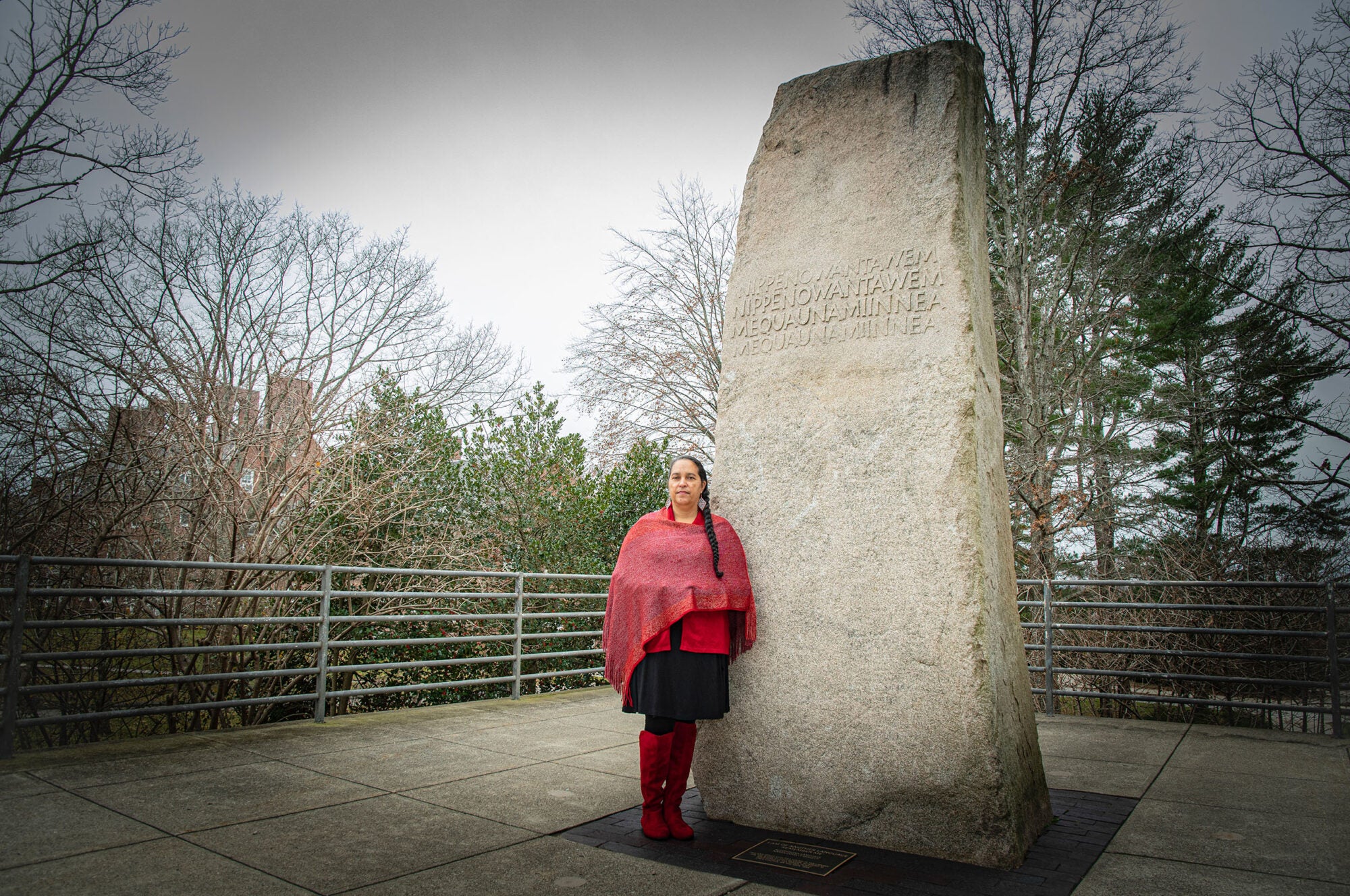
Lorén Spears ’89, Hon. ’17, director of the Tomaquag Museum, beside a large stone monolith outside the URI library. The monolith represents the only visible acknowledgement at URI of the Narragansett Nation. Completed in 1994, it is the work of Newport artist John Benson.
By Marybeth Reilly-McGreen
A new multidisciplinary undergraduate course offers students opportunities to discover and preserve a more complete history of the land on which the Kingston Campus sits. From the land itself, to how buildings are named, to the changing experience of women on campus, the course will be shaped—as the University itself has been—by those who are a part of it.
It’s a bone-cold December day, and the atmospheric pressure presages the snow predicted for mid-afternoon. Lorén Spears ’89, Hon. ’17, executive director of the Tomaquag Museum, arms folded under her shawl, stands for a portrait beside the 12-foot-high Westerly red granite monolith on the Robert L. Carothers Library and Learning Commons plaza. The monolith leaves her a little cold.
The monolith’s text, phonetic spellings of Narragansett words taken from Roger Williams’ A Key into the Language of America, reads “Nippenowantawem Nippenowantawem Mequanamiinnea Mequaunamiinnea.” Translated, the phrase, which repeats, means, “I am of another language. Remember me.” The call to “remember” the Narragansett people implies that the tribe no longer exists, Spears explains.
A new multidisciplinary course, URI Campus: A Walk Through Time, aims to correct such errors as it examines the history of the land on which the Kingston Campus sits.
Spears is frank and forthright in talking about how settler colonialism devastated the Narragansett Tribe and how that history relates to URI. The arrival of European colonists was cataclysmic for her ancestors. An initial offensive of war, enslavement, rape, and murder was followed by policymaking and legislation that left the Narragansett people much reduced in number and largely stripped of ancestral lands and power.
The University of Rhode Island’s Kingston Campus sits on Narragansett ancestral land. In light of that, Spears says, some have questioned why the Tomaquag Museum, which has plans to build a new facility on 18 acres of university land, would seek to collaborate with the University.
“My answer has always been that if you want people to broaden their perspectives or to hear or understand a broader Native perspective, you have to collaborate,” Spears says. And those collaborations can be impressive in scale—such as the new museum, which will comprise four buildings and cost $104 million—or in scope, such as this new course, which enlists undergraduates in research that will educate generations to come.
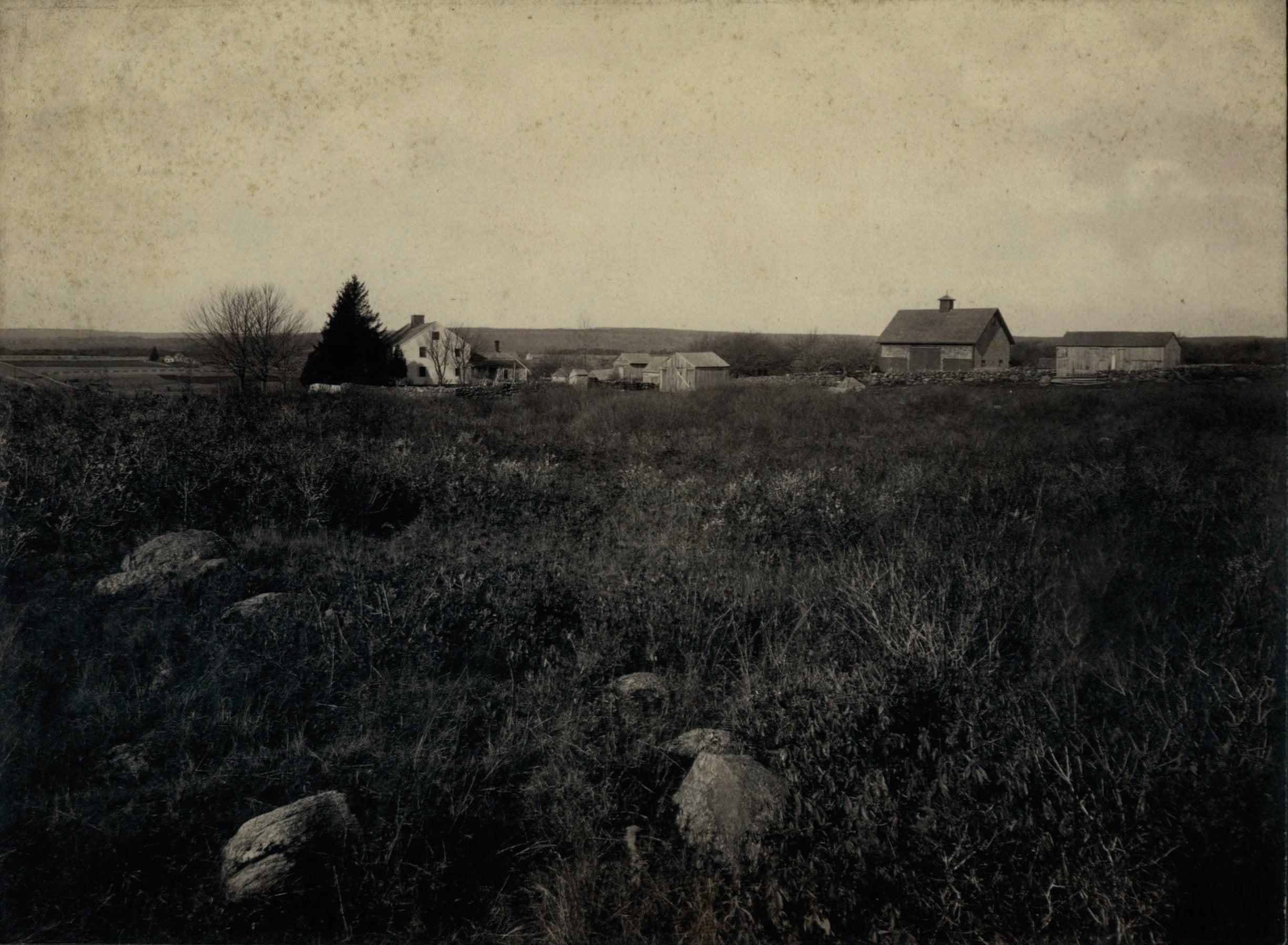
Watson House still stands, the oldest structure on URI’s Kingston Campus, a visible reminder of the University’s history. Organizers of A Walk Through Time aim to reveal a more complete history, including that of the Indigenous people upon whose ancestral land the University sits.
The 140-acre Oliver Watson Farm was built around 1796 and purchased by local citizens in 1888 to be used as an agricultural experiment station and school.
This is a complicated history
URI Campus: A Walk Through Time started as a walking tour in 2019. Organized by several academic departments in collaboration with the Tomaquag Museum, the tour was well-received, spurring Spears, along with Kristine Bovy, archaeologist and chair of URI’s Department of Sociology and Anthropology; Rod Mather, historical archaeologist and then-chair of the Department of History; and Catherine DeCesare, historian and assistant professor of history, to co-create a one-credit, one-time online course in 2020. A course for alumni followed in 2021. Later that year, the organizers reconvened to deliver a URI Center for the Humanities lecture as part of the center’s yearlong series, Memorials and Commemoration in the U.S. In spring 2022, undergraduates took a three-credit honors version of the course led by DeCesare.
Team-taught and interdisciplinary, A Walk Through Time is ambitious and mutable. Each semester, the focus of the course will change, depending on the interests and expertise of the principal professor teaching it. DeCesare’s focus is women’s history—specifically women’s experiences at URI in the 1960s and ’70s. The course’s aim remains constant, though: to educate students about “the long and complicated history of the URI campus land, including ancestral Narragansett land use and effects of European colonization,” according to its syllabus.
The course spans 5,000 years of history, moving from present to past as it juxtaposes URI’s development with the history of the Narragansett people using a variety of resources: written documents, maps, artifacts, photography, oral histories, and law. The course provides a unique opportunity for undergraduate students to conceive and conduct original research through projects that will become source material for subsequent classes. Theory is, in effect, put into practice as students pursue projects requiring them to evaluate sources and evidence with the critical eye of anthropologists, historians, and archaeologists.
Spears is pleased with the progress thus far.
“When we did the first walk, the first thing I did was to speak in my language, to acknowledge the land that we’re on, to open with what some people would deem a prayer or a blessing, and to ground us in this place,” she says. “As people have become more aware of historical inequities and the voices missing from conversations around our history, there’s been this move to include more voices. Working at Rhode Island’s only Native-led museum opens the door for us to partner on these kinds of projects.”
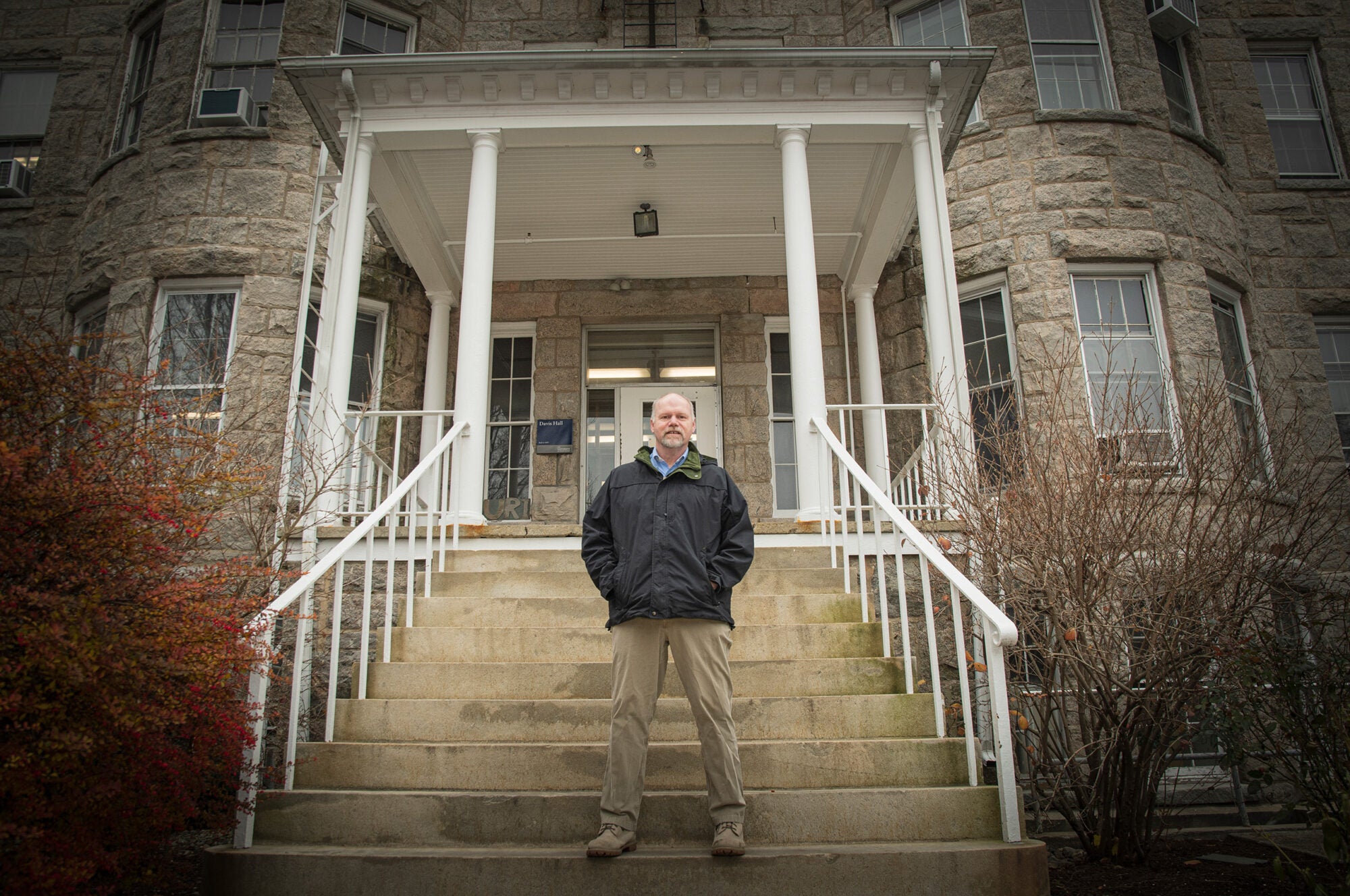
Rod Mather, historical archaeologist
This is a global conversation
A Walk Through Time tethers history to material features of the campus. Green and Quinn halls recall the campus of the 1930s; the Quad, the last decade of the 19th century and first decade of the 20th century. The Watson House addresses 18th- and 19th-century Colonial farming; the Niles Burial Ground (aside the south entrance to the Ryan Center) recalls the 17th century. Plains Road and its adjacent parking lots become the backdrop for thousands of years of Indigenous people’s land use. “The focus of the walking tour was this relationship between the University, American traditions, Indigenous people, the land, the landscape’s history, and ways of knowing,” Mather says.
Mather expects that the archive the course generates will expand to include other historically underrepresented groups.
“The URI campus is a cultural landscape, a built environment representing our priorities, our prejudices, what we want to remember, and what we want to forget, too.”
—Rod Mather, historical archaeologist
“Everything we’ve done so far has focused on this relationship between Euro-Americans and Indigenous people, but there are other stories we haven’t told yet. Catherine DeCesare is looking at women on campus. We would also like to look more thoroughly at the African American experience on campus.”
Each of the three professors involved in the project intends to pursue discrete lines of historical inquiry that reflect their respective areas of expertise. “My central interest is the campus as cultural landscape. When you read the cultural landscape, when you understand how people have been using a place, you understand what their priorities are, how they affect the place, how the natural environment shapes the way people live in the space, and the kinds of resources they’re trying to extract,” Mather says. “The URI campus is a cultural landscape, a built environment representing our priorities, our prejudices, what we want to remember, and what we want to forget, too.
“The construction of the landscape, for instance, is full of conscious and subconscious meaning,” Mather continues. “And it reinforces certain messages, right? So, if we have 95 percent of our buildings named after white men, then that conveys something.”
And so, looking at the names of campus buildings in the aggregate invites analysis of institutional priorities over time—and a deeper understanding of the cultural landscape in which the URI community lives, learns, and works. Mather sees this as a welcome opportunity for course correction. “We can’t continue along the road we have, and the first thing to do is to raise awareness, to start the conversations. And then, from the conversations come actions.
“All over the country, universities are starting to come to terms with their own racial geography,” Mather says. “There’s been a reckoning across university campuses that’s important. Land-grant institutions, the whole land-grant system, as wonderful as it was in many ways, was predicated on taking land that the federal government had acquired through treaty or seizure or military action from Indigenous people. So land-grant colleges and universities have got to think about this.
“The conversation is not just a URI conversation. This is a national and global conversation.”
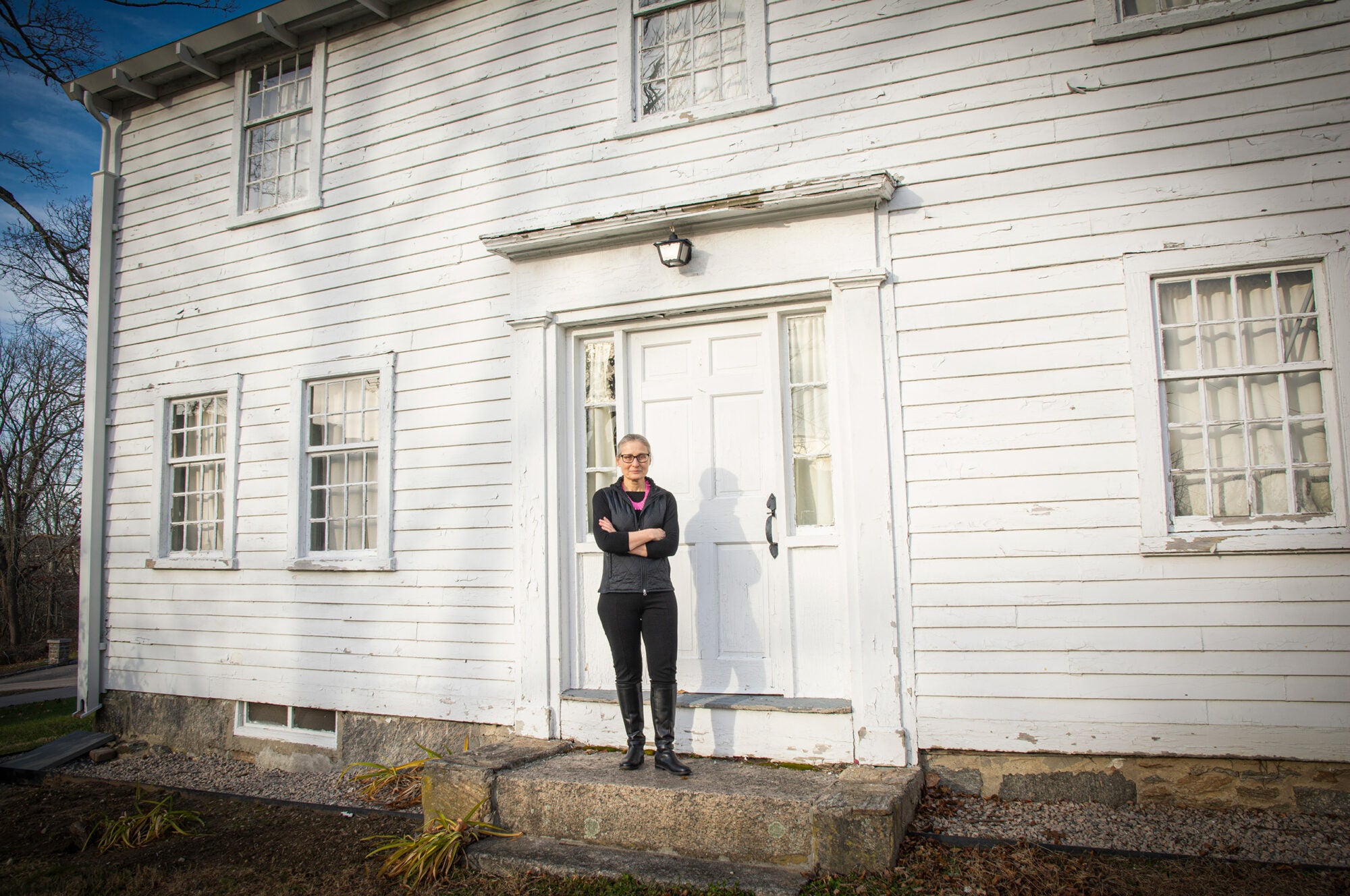
Catherine DeCesare, assistant professor of history and one of the course instructors, on the steps of Watson House.
This is breaking new ground
Given her expertise in Rhode Island history and women’s history, DeCesare has expanded the course. In 2021, she enlisted Abigail Dodd ’22, a College of Arts and Sciences undergraduate research fellow, to comb university records for women’s involvement on campus over a 30-year span beginning in the 1950s. Dodd’s list will become a resource for future students in the course. DeCesare has also partnered students in the course with URI graduates who participated in the alumni course. Her students will interview the alumni to create an oral history of campus life.
“We are not rewriting history. We are including facets that have been erased from the documentation of the history.”
—Lorén Spears ’89, Hon. ’17, director, Tomaquag Museum
“Students are working on major projects, building out narratives on topics of their choice—for example, women’s sports, Title IX, sororities, or majors. The most prominent major in the 1950s and 1960s was home economics, and [through their alumni interviews] they’ll see that transition.” DeCesare is describing how her students will see that over time, the areas of study or activity in which women on the URI campus have been involved has transitioned or expanded.
Students’ archival research, presentations, and oral reports will be preserved for subsequent student scholars’ use. Over time, the archive will grow as students conduct and interpret original research destined to become part of the University’s—and Rhode Island’s—historical record. Put another way, the students will become historians. DeCesare is excited at the prospect.
“This is breaking new ground in terms of historical research and finding new voices and things to write about,” DeCesare says. “I mean, this is what it’s all about.”
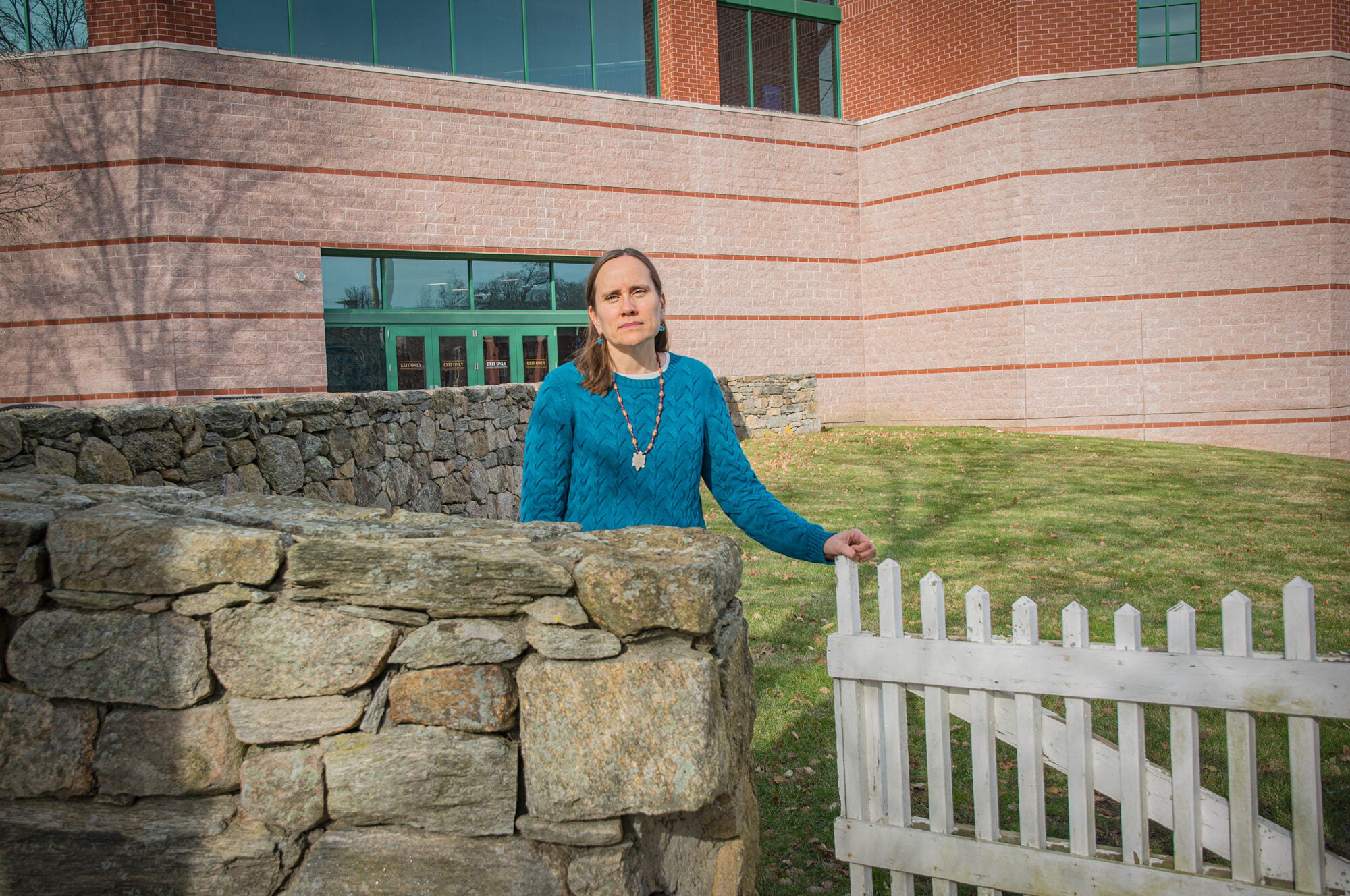
Kristine Bovy, archaeologist and chair of URI’s Department of Sociology and Anthropology, at the Niles Burial Ground, outside the south entrance to URI’s Ryan Center.
This history is invisible
Situated in the shadow of the Ryan Center, Niles Burial Ground is easily overlooked. Stone walls and a white picket gate enclose land believed to hold “the remains of the ancient and diverse settlers,” according to a plaque affixed to the stone wall, which is the burial ground’s only marker. There are no headstones here. The plaque’s last two sentences explain why: “This burial ground could contain the remains of the Niles family as well as Native Americans and African Americans who worked this land. It is preserved to acknowledge our past and enrich our future.”
For Spears, the language of commemoration is often vexing. In her Center for the Humanities lecture last fall, Spears began, “I must acknowledge the 400 years of conquest colonization, genocide, land dispossession, enslavement, forced assimilation, detribalization, and erasure of the Narragansett and other Indigenous nations of the Americas. I must also acknowledge the bravery, resilience, perseverance, and adaptability of our ancestors, who ensured our continuation, passing forth our traditional ecological knowledge, language, history, and culture, while contributing to the creation of this colony, state, and country.
“There is no U.S. history without Indigenous people’s history, and there is no Rhode Island history without Narragansett, Niantic, and other Indigenous people’s history. This is our homeland since time immemorial. We are still here.”
So, Spears contends, to say Native and African Americans “worked the land” does more than just skirt the issue. Such language obfuscates, conceals, and dissembles. It undermines the historical record.
“When people say of Indigenous peoples, ‘Oh, they were servants.’ No, we weren’t servants. We were slaves. Because we were forced, kept against our will for long periods of time, and victimized by violence.”
Besides language or description that undermines the historical record, there are gaps, or archival silences, in the record—periods of history in which the experiences of some groups of people are undocumented, omitted. How do you address that? What can be done for the nameless who may be interred in Niles Burial Ground, for instance? What can be done when there is no historical record from which to begin? Bovy and her colleagues see A Walk Through Time as a multipronged method to address, augment, and amend the past.
“As archaeologists and historians, we realized that this land had a much deeper past, a much deeper history,” Bovy says. “We initially focused on the history of the University, and especially the Narragansett ties to this land because this history is invisible to most members of our community.”
That the collective energies of scholars with differing areas of expertise are being brought to bear on the history gets to a more complete picture, too. Archaeology, history, museum archival work—each informs and complements the others.
“Archaeology is another way that we know about the past. We systematically excavate objects; we record their context, and we analyze them,” Bovy says. “And the power of archaeology is really in providing information about people and activities that is left out of written records.”
Supplement the disciplines with the power of an inquisitive and motivated student body and progress is assured.
“Our students will help us do the research and fill in some of the gaps in these important periods of time,” Bovy continues. “They’ll help build out that content. We’re going to highlight what is visible, what’s invisible, what’s remembered and not remembered, and what’s memorialized and not memorialized on this land.”
The truth is the truth
Opportunities to recover erased histories have the potential to expand minds, Spears says. For that reason, she says, the University will find a willing partner for this work in the Tomaquag Museum. Beyond the obvious benefit of building an archive, Spears believes a course like A Walk Through Time can move the community past errant history toward a more equitable—and honest—future. Eventually, Spears hopes there’ll be enough material compiled to create a Native studies program at URI.
“Partnerships like A Walk Through Time broaden people’s understanding of the history of this campus and take it beyond the literal creation of the campus. People like to term such things ‘revisionist history.’ I disagree wholeheartedly. We are not rewriting history. We are including facets that have been erased from the documentation of the history.”
Spears invokes the words of the late Ella Sekatau, Narragansett poet, historian, ethno-historian, and medicine woman, to punctuate her point:
“The truth is the truth is the truth—waiting to be recovered.” •
Photos: Nora Lewis; Bruno Pereira; URI Special Collections

I attended an online course on the history of the university (last year, I think), taught by the professors mentioned above. It was eye opening and I am so glad to see a set of courses being introduced into the curriculum. I would love to see how it is received by students and how it progresses and grows. My best wishes to the instructors and a big thank you for starting this.
It is important when looking at specific aspects of the History of URI to take a positive view of what was happening at the time not what it should have been thru the eyes of someone writing in 2022.
I attended the Alumni version of this and although informative felt more documented research needed to be done and more balanced views about URI being a Land Grant College and the courses and activities being offered that reflected all the students and activities over the years not just one segment of the population.Take a look at the old yearbooks and the Extension Service,the importance of the Agricultural college and how the people of the state have benefited .
Looks like a 1 credit course that could be open to the public.
and was a Home economics major